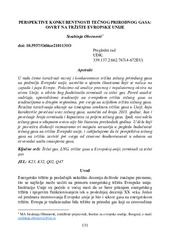Приказ основних података о документу
Perspektive konkurentnosti tečnog prirodnog gasa: osvrt na tržište Evropske unije
Perspectives on LNG competitiveness: An overview of the EU market
| dc.creator | Obrenović, Strahinja | |
| dc.date.accessioned | 2023-10-09T12:20:12Z | |
| dc.date.available | 2023-10-09T12:20:12Z | |
| dc.date.issued | 2021 | |
| dc.identifier.issn | 2217-401X | |
| dc.identifier.uri | http://rfpn.fpn.bg.ac.rs/handle/123456789/1042 | |
| dc.description.abstract | U radu ćemo istraživati razvoj i konkurentnost tržišta tečnog prirodnog gasa na području Evropske unije, naročito u njenim članicama koje se nalaze na zapadu i jugu Evrope. Polazimo od analize pravnog i regulatornog okvira na nivou Unije, u okviru kog funkcionišu terminali za tečni gas. Pored analize sadržaja, uporedićemo tendencije na evropskom tržištu tečnog gasa sa tendencijama u drugim regionima, pre svega na azijskom tržištu tečnog gasa. Rezultat istraživanja ukazuje na izmenjenu strukturu tržišta gasa u Uniji, koju karakteriše povećani uvoz tečnog gasa, naročito od kraja 2018. godine, kao i povećanje broja terminala i kapaciteta za prijem tečnog gasa. Ipak, rast udela tečnog gasa u ukupnom uvozu nije bio linearan prethodnih godina. U delu koji je posvećen diskusiji razmatramo tri moguća scenarija u pogledu budućnosti tečnog gasa na tržištu Evropske unije, i zaključujemo da će perspektiva tečnog gasa na tržištu zavisiti pre svega od cenovne konkurentnosti u odnosu na cevovodni način transporta gasa. | sr |
| dc.description.abstract | In this paper we research the development and competitiveness of the LNG (Liquified Natural Gas) market in the European Union, especially in its member states located in west and south of Europe. First, we analyze legal and regulatory framework at the EU level, under which LNG terminals and facilities operate. In addition to content analysis, we also compare trends in the European LNG market with trends in other regions, especially in the Asian LNG market. The result of the research highlights the changed structure of the EU’s gas market, characterized by larger imports of liquefied natural gas, especially since the end of 2018, as well as increased number of terminals and capacities for receiving liquefied gas. However, the growth in the share of liquefied gas in total import was not linear in the previous years. As a part of the discussion we examine three possible scenarios regarding the future of LNG market in the European Union, and we conclude that the perspective of LNG in the market will primarly depend on price competitiveness comparing it to pipeline gas transport. | sr |
| dc.language.iso | sr | sr |
| dc.language.iso | en | sr |
| dc.publisher | Beograd : Centar za ekonomska i finansijska istraživanja | sr |
| dc.rights | openAccess | sr |
| dc.rights.uri | https://creativecommons.org/licenses/by/4.0/ | |
| dc.source | Oditor | sr |
| dc.subject | Tečni gas | sr |
| dc.subject | LNG | sr |
| dc.subject | tržište gasa u Evropskoj uniji | sr |
| dc.subject | terminali za tečni gas | sr |
| dc.subject | Liquefied natural gas | sr |
| dc.subject | LNG | sr |
| dc.subject | EU gas market | sr |
| dc.subject | LNG Terminals | sr |
| dc.title | Perspektive konkurentnosti tečnog prirodnog gasa: osvrt na tržište Evropske unije | sr |
| dc.title | Perspectives on LNG competitiveness: An overview of the EU market | sr |
| dc.type | article | sr |
| dc.rights.license | BY | sr |
| dc.citation.epage | 163 | |
| dc.citation.issue | 1 | |
| dc.citation.rank | M24 | |
| dc.citation.spage | 131 | |
| dc.citation.volume | 7 | |
| dc.identifier.doi | 10.5937/Oditor2101131O | |
| dc.identifier.fulltext | http://rfpn.fpn.bg.ac.rs/bitstream/id/2793/fulltext.pdf | |
| dc.type.version | publishedVersion | sr |

